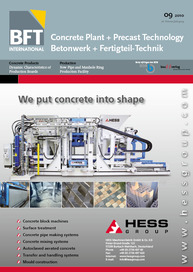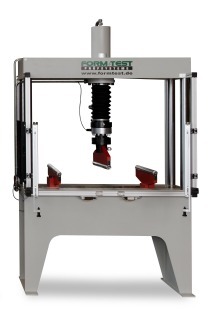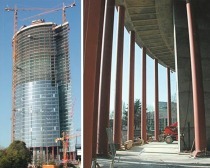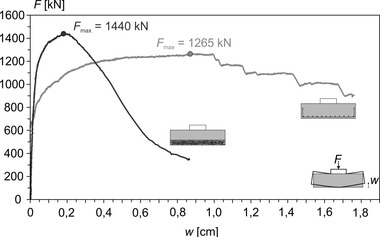Innovative Precast Girders of Fiber and High-Performance Concretes
The paper reports on the use of steelfiber-reinforced concrete in combination with pretensioned reinforcement for girders and beams. The result, it was found, is an innovative, economical construction product of high technical quality. Based on these findings and the structural models, the use of pretensioned double T-slabs and UHPC girders is demonstrated on pretensioned double-T slabs and UHPC girders. In conclusion, the investigations into innovative hybrid girders with UHPC bars that greatly facilitate the use of UHPC in concrete practice as well as hybrid girders with perforated sheet reinforcement that enable girder systems with very large web openings, are presented.
The stationary production processes offer precast construction optimal possibilities for applying high-performance concretes, for which remarkable developments have taken place (Fig. 1). Self-compacting concretes (SCC), high-performance concretes (HPC) and ultra-high performance concretes (UHPC) are representative for these. As of late, the term “performance-based concrete” is coming into use to describe a concrete made for special applications and utilizations. The result is a multifarious spectrum of optimization possibilities. In this context, the use of fibers also plays an important role. Through their use, an economical construction product of high technical quality can be obtained, in particular for precast members in combination with pretensioned reinforcement. At the iBMB of TU Braunschweig, numerous experimental and theoretical investigations have been performed on precast girders in connection with the use of fiber and high-performance concretes. The following article provides an overview of these investigations.
Pretensioned reinforced-concrete girders
In the production of reinforced-concrete girders, the installation of the reinforcement takes up a considerable share of manual labor and other costs. Fig. 2 illustrates that for industrial buildings constructed of precast reinforced-concrete members, independent of the quantity-specific and deadline constraints imposed on the construction project, the production costs and the costs of the reinforcement each take up approx. 30 %. Both authoritative factors, i.e. the materials costs of the reinforcement and the cost of manual labor for its installation are the starting points on which the optimization possibilities for pretensioned precast girders are based.
Steel fibers offer themselves as an alternative reinforcement possibility and therefore as substitute for conventional steel reinforcement. This principle is based on the tests of structural members on the shear resistance of reinforced-concrete beams carried out by Rosenbusch [2] and the structural mathematical model for determining the shear resistance of steelfiber-reinforced concrete. From the standpoint of execution and production technology it is expedient that the substitution of conventional steel reinforcement by steelfibers is aimed to cover both stirrups and longitudinal reinforcement. In pretensioned girders, used for industrial buildings as roof trusses, these types of reinforcement are required for checking the minimum reinforcement and the robustness of reinforcement as well as the surface reinforcement, or they are required for other reasons, e.g. for the reinforcement along edges. Fig. 3 compares the design principles of the pretensioned precast girders in terms of quality. The steelfiber-reinforced concrete girder is a girder with so-called “combined reinforcement,” which ensures load transmission via the combed effect of pretensioning stress and the effect of the steelfibers.
Through pretensioning, compressive longitudinal forces are applied from the end of the girder into the member, which bridge the tensile stresses from the external actions. For this, the pretensioning for the applied loading states is so dimensioned that no longitudinal steel reinforcement is necessary for ensuring the flexural tensile strength in the ultimate limit state. The pretensioning forces moreover lead to a kind of truss effect, as shown in a simplified way in Fig. 4 and on a crack pattern in a test, which positively affects the pretensioned steelfiber-reinforced concrete girder.
The shear resistance can be further increased by the effect of the steelfibers added. Characteristic of steelfiber-reinforced concrete is that the concrete, after having exceeded the tensile strength of the concrete – other than is the case with unreinforced concrete – still possesses a significant post-cracking tensile strength (Fig. 5, top), whose magnitude, e.g. according to [3], is determined in a 4-point bending test and, following a statistical evaluation, is rated in performance classes. A deflection of 0.5 mm here is representative for the serviceability limit state and a deflection of 3.5 mm for the ultimate limit state. The shear resistance of the pretensioned steelfiber-reinforced concrete girder then consists of the shear bearing contribution of the compressive concrete zone Vcc, crack keying Vcr and the dowel effect of the reinforcement Vd and the fiber content Vf, as qualitatively shown in Fig. 5, bottom. With regard to the magnitude of fiber content Vf, not only the quantitative dimensioning is important. Rather, the steel-fiber type and the steelfiber content for the production must be so dimensioned – apart from the required performance capacity – to enable fully satisfactory production and processing of the concrete mix in the precast plant. In addition, the mix and the manner of processing must ensure a uniform distribution and orientation of the steelfibers in the member in order to guarantee a reliable application of the design method with the assumptions it is based on.
In [4], the loadbearing and deformation behavior of pretensioned steelfiber-reinforced concrete girders without conventional steel reinforcement in service condition and in the serviceability limit state was subjected to a detailed experimental investigation. The structural behavior of this girder is basically characterized in that the pretensioning and the use of the steelfiber concrete result in a very fine crack formation and very small crack widths so that the deformation behavior deviates only a little from the uncracked condition. Under further loading, the cracks open slowly and the girders, after exceeding the yield point of the pretensioned reinforcement, exhibit a ductile structural and deformation behavior. The ultimate limit state announces itself through wide cracks and large deflections so that the pretensioned steelfiber-reinforced concrete girders possess sufficient robustness (Fig. 6).
The experimental results – aside from clarifying the basic structural mechanical models – also served as database and basis for the calibration for an extended numeric investigation of member parameters by the finite element method, such as cross-section shape, degree of pretensioning, fiber performance classes, arrangement of recesses and loadings as well as the design of supports. Fig. 6 presents, by way of example, a comparison of the load-deflection curves and the experimentally and numerically determined crack patterns. In both cases, a good agreement could be determined.
All in all, the experimental investigations show that a combination of pretensioning and steel fibers is a possible substitute for steel reinforcement and that the pretensioned steelfiber concrete girders are technically equal to conventionally pretensioned concrete girders, both in service condition and in the ultimate limit state. The outstanding properties of girders of this type in service condition ensure moreover a long service life.
With a view to their application in concrete practice and the requirements of the building services recess diameters of up to 40 % of the member height can be realized. More extensive recess configurations require the installation of appropriate additional reinforcement devices. A sufficient fire resistance duration of F90 – if not directly provided by the concrete used – can be ensured through the addition of PP fibers.
As this construction method is not regulated by the building authorities and does not fall within the scope of the future DAfStb code of practice for steelfibers [3], an approval on a case-to-case basis or a general technical approval is required for application in concrete practice ([6 - 9]).
The pretensioned precast girders with alternative steelfiber reinforcement, thanks to the savings in steel reinforcement and the complex reinforcement works, provide a notable competitive edge over conventional precast girders and have already been used with great success in various construction projects. Based on these very good experiences, the application spectrum can be extended, for example, to other cross-sectional shapes, larger girder lengths, additional recess configurations, other types of girders (e.g. double-T slabs), or the use of high-performance concretes.
Pretensioned double-T slabs
For larger spans in industrial and hall construction, the double-web slab, also known as double-T or Pi-slab has asserted itself, all of which possess a high flexural stiffness at a minimized weight. A distinction is made between double-T slabs topped with in-situ concrete and double-T slabs without in-situ concrete topping as well as between double-T slabs with non-pretensioned reinforcement or with pretensioned reinforcement. Double-T slabs are used either as roof floor or as division between one story and another. For the first, the load imposed on it is relatively low – despite the large spans that are often required and which are largely uniformly distributed. For floors between stories, the loads are higher and double-T floor slabs with an in-situ concrete topping of 5 cm to 10 cm are commonly used. The surface of these floors is level and the horizontal diaphragm action of the floor slab moreover positively affects the overall stabilization of the structure and can be applied accordingly.
The double-T slabs without steel reinforcement can be manufactured in analogy to the above-described steelfiber-concrete girders. The flexural capacity is ensured by the pretensioning compressive longitudinal force. The shear force bearing capacity is ensured by the contribution of the concrete, the strutted frame of the pretensioning as well as the contribution of the fibers. The requirements made on the minimum longitudinal reinforcement and the minimum shear reinforcement to ensure the ductility and on the surface reinforcement are substituted and ensured by the loadbearing effect of the steel fibers. In contrast to the pretensioned girders, the loadbearing effect of the double-T slabs relative to the shear resistance of the chord is more complex. Due to the transverse bending of the cantilever slabs, resulting from the concretes own weight as well as the basic principle of the dimensioning of the steelfiber concrete, to the effect that with statically determinate systems that derive their flexural strength exclusively via the steelfibers of an individual cross-section, the cross-sectional equilibrium has to be ensured through additional reinforcement; the installation of an upper reinforcement in the upper concrete layer is in any case required. This can, for example, consist of ready-made lattice girders. These can then simultaneously serve as bond reinforcement and as spacers for the slab reinforcement in the in-situ concrete topping.
Within the scope of the investigations carried out, a calculation of a steelfiber-reinforced pretensioned double-T slab was performed on the finite-element model referred to above. Fig. 8 shows a quarter model of a double-T slab of 12.5 m length and 62.5 cm high and the load-deformation behavior numerically determined with it, making use of the symmetrical conditions. Here, again, only very small crack widths and deformations occur in service condition. In the ultimate limit state, the double-T slabs shows a robust and ductile behavior, failure announces itself by a marked crack formation.
Based on the results of the investigations it can be concluded that the technical and economical use of pretensioned double-T slabs of steelfiber concrete is certainly possible for the roof slabs that are subjected to only low shear loading. For use of the pretensioned double-T slabs as floor slabs, the higher loadings and the possibly greater point loads must first of all be mapped with more precision and, secondly, an increase in the shear resistance be provided for with, for example, a higher pretensioning force (strutted frame) or by an increase of the performance capacity of the fibers (fiber effect). The use of double-T slabs as floor slabs subjected to dynamic loads, should be clarified in more in-depth investigations.
Double-T slabs, due to their limited construction height, are frequently manufactured with stepped supports. The recessed corner and the resulting singularity lead to high stress concentrations that cannot be covered by a pure steelfiber concrete solution. Here, the installation of embedded steel parts or system solutions, as shown in Fig. 9, is necessary, which would require simple reinforcement work in a very limited spatial area.
Pretensioned HPC and UHPC girders
Plans for modern constructions increasingly call for slender members of low self-weight and large spans. A design using modern high-performance concretes in combination with the pretensioned steelfiber-reinforced concrete girders could well meet the requirements of the target specifications for such structures.
High-strength concretes (HPC) and ultra-high strength concretes (UHPC) are characterized by high to very high compressive and tensile strengths. UHPC, for example, can currently attain compressive strengths of 200 N/mm² and centric tensile strengths of 10 N/mm². In this way, savings in concrete material can be achieved, particularly in the compression zone, leading to reduced weight and, in turn, lower costs for transport and installation. High-performance concretes of that kind, moreover, thanks to their dense concrete structure and the very low porosity, possess outstanding durability characteristics [11].
However, the failure mode of high-performance concrete subjected to high loading in compression becomes increasingly brittle, the higher the concrete grade, up to the point of a near-explosive failure mode. Fig. 10, on the top, shows the remainders of an experimental UHPC cylinder following a standard compression test in the laboratory. For this reason, the required ductility in concrete practice has to be ensured through the use and addition of fibers. Fig. 10, on the bottom, shows the effect the addition of fiber has on the post-cracking behavior in a compression test.
In respect of the fiber addition, the various UHPC vary widely. Based on an UHPC with high-strength short fibers (lf / df = 9 mm / 0.15 mm) and fiber contents of 200 kg/m³; the DFG priority program 1182 is making intensive efforts to optimize fiber type and fiber content, including, in part, the investigation of so-called “fiber cocktails.” It was found that the use of fibers of medium length (lf / df = 30mm / 0.8 mm) at approx. 100 kg/m³ can lead to similar fiber performance capacities as the use of short fibers [12].
Based on the high steelfiber content it appears only logical to apply the concept to the design and dimensioning of pretensioned girders made of UHPC. Within the scope of the DFG priority program 1182, comprehensive experimental investigations were carried out on UHPC girders [13] that show the mechanisms of action of the strutted frame effect and the loadbearing effect of the steelfibers also for UHPC girders. In own numerical studies, building on the FE models in section 2 „Pretensioned reinforced-concrete girders“ and following adjustment of the relevant materials models, the service behavior and the structural behavior of UHPC girders were investigated. The aim was to develop a girder of C 150 with, compared to a girder of normal concrete (C 50), noticeably reduced the cross-sectional dimensions, while the stiffness conditions remain equal. Fig. 11 illustrates that the load-deformation behavior of the UHPC girders (C 150) equals that of the pretensioned reinforced concrete girder made of C 50. The same stiffness exists in service condition and, after exceeding the yield point of the pretensioned reinforcement, large cracks and deformations occur so that, again, a ductile behavior occurs, announcing failure. The comparison of masses in Fig. 11 demonstrates that with a C 150 – compared to a C 50 – the cross-section can be reduced by approx. 50 %, with the deformation behavior being equal. The cross-section of the pretensioning steel required for this amounts to only approx. 80 % of the pretensioning steel area of a C 50.
Accordingly, the design principle of the pretensioned steelfiber concrete girder can also be applied to high-performance concretes. With it, extremely durable girders with fine crack distribution and small crack widths can be realized through the addition of fibers and which, thanks to the materials properties, enable a slender execution with low own weights, predestining them for use for large and very large spans.
Hybrid girders
“Hybrid girders” in the sense of this paper are pretensioned girders made of mixed concretes or different types of reinforcement.
Fig. 12 shows one design possibility for “hybrid girders.” Here, so-called “UHPC bars” are built into the compression zone – quasi as compression reinforcement. Since these UHPC bars possess about three times the strength of the surrounding normal concrete, the bending compression zone can be reduced accordingly and weight saved. The great advantage of these UHPC bars is that the high quality and mechanical requirements made on UHPC are needed only for the manufacture of these UHPC bars and that these can in some circumstances also be manufactured externally. As “finished product” they can be simply tied into the reinforcing cage and the manufacturing process of the entire girder can then proceed as usual. This makes it possible for every precaster to make use of the extraordinary properties of a UHPC without extra cost in the normal production process.
Another approach for the design of “hybrid girders” is the use of alternative shear reinforcement. In preliminary studies, the use of perforated sheet metal in pretensioned concrete girders with large recesses was numerically examined. The large recesses on the web openings cause deflections of the compression strut and tension strut forces as well as structural frame and moment actions in the upper and lower chord. A design, for example according to Neff [14], requires on these recesses large quantities of reinforcement, whose installation is very time- and cost intensive. The aim should therefore be to totally cover the various loadings imposed on bars and chords by high-performance reinforcement. This reinforcement, moreover, should also be easy to install. Fig. 13 presents the design principle, a tension plot of an FE computation as well as the numerically determined load-deformation behavior. Pretensioned concrete girders of this type with large openings can compete with composite steel girders, e.g. open-web girders, and will soon be further investigated in an applied for AiF project.
Summary
Precast, pretensioned concrete girders, compared to in-situ concrete girders, are characterized by their high quality of execution and a high quality of the concrete member as well as short construction times. The stationary production processes offer precast construction optimal possibilities for using modern high-performance concretes and alternative forms of reinforcement, providing a wide and varied spectrum of optimization possibilities.
The paper reports on the use and invetigations of steelfiber-reinforced concrete in combination with pretensioned reinforcement for girders and double-T slabs. In conclusion, the inverstigations into innovative hybrid girders with UHPC bars or with perforated sheet reinforcement are presented.

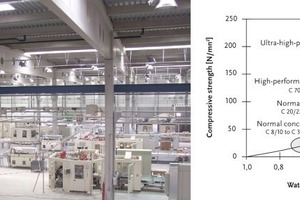
![Fig. 2 Cost structure of industrial buildings constructed of reinforced concrete parts [1].](https://www.bft-international.com/imgs/tok_8d72560de88bff08c141ae558a89b4fd/w300_h200_x400_y227_103946688_c84fbce5db.jpg)
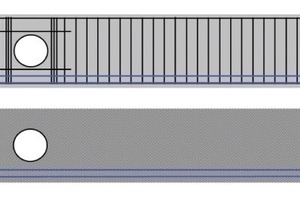
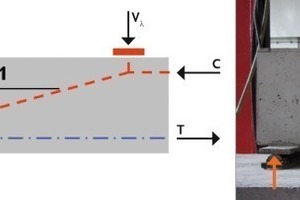
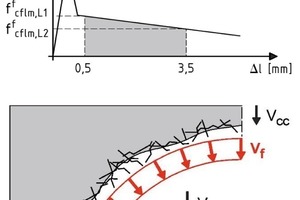
![Fig. 6 Pretensioned steelfiber concrete girder; load-deformation behavior (top left), experimental photo (top right) and crack pattern (bottom) [5].](https://www.bft-international.com/imgs/tok_1868a53725ab65ec9af86bf789d8e9d5/w300_h200_x400_y204_103946638_d7c0cdec38.jpg)
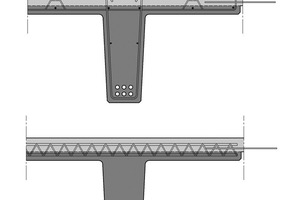
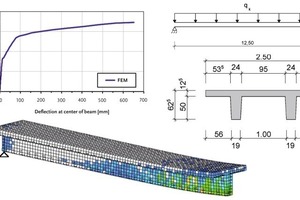
![Fig. 9 System solution for stepped supports with double-T slabs [10].](https://www.bft-international.com/imgs/tok_1bd5fd2b75b7788f02cad445d93f41a4/w300_h200_x400_y196_103946697_c807a17f03.jpg)
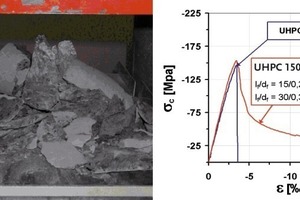
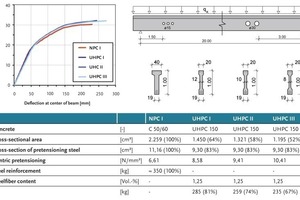
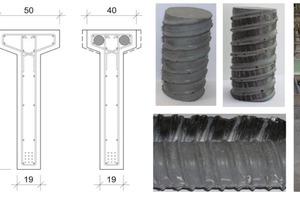
![Fig. 13 Comparison between a girder reinforced according to Neff [14] and a girder with perforated sheet reinforcement; load-deformation behavior (top left), design principle of a hybrid girder (top right) and principal compressive stress plot (bottom).](https://www.bft-international.com/imgs/tok_bc1e078eb7dafdb134c4ec316542655a/w300_h200_x400_y206_103946622_5c873793e4.jpg)




